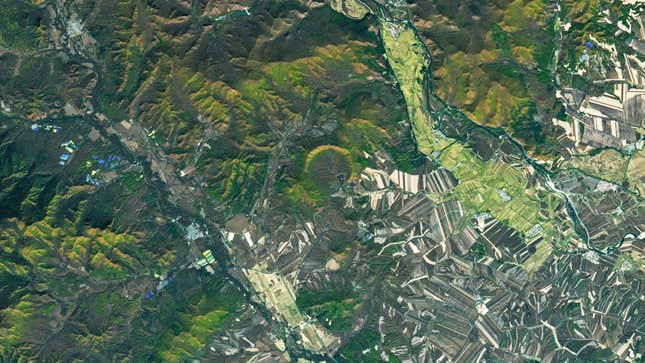
In 2019, researchers first described a 1.15-mile-wide crater in a mountain range in northeast China; late last year, a NASA satellite imaged the crater from space, giving a broad new view of the impact’s aftermath.
The crater is in Heilongjiang Province’s Yilan County. According to the researchers who described it in 2019, it’s the second confirmed impact structure in China. The site has long been known to locals, who call it “Quanshan,” or “circular mountain ridge,” according to a NASA Earth Observatory release.
The southern rim of the crater has eroded, so from above the impact site looks more like a crescent. The rim is nearly 500 feet tall at its highest points, the researchers reported, and is slightly wider than China’s previously confirmed impact strucgture, Xiuyan, which is 1.12 miles across.
This image was captured by the Operational Land Imager aboard Landsat 8 on October 8, 2021. Farmland is visible to the southeast, and on the right side of the image is the Balan River.
Last year, a different team of researchers determined that the crater formed between 46,000 and 53,000 years ago, making it the largest crater less than 100,000 years old. They figured out that the crater was formed by an asteroid by drilling nearly 1,500 feet into its center, where they found melted stone, shocked quartz, and glass in the ancient sediments—evidence of a high-temperature blast. Radiocarbon dating of the shocked sediments gave researchers the surprisingly recent date.
The size of the asteroid that made the crater is uncertain, but it wouldn’t have been nearly as large as the huge depression it left. For reference, Arizona’s Meteor Crater is 0.75 miles wide, but NASA scientists believe the asteroid that created it was just 150 feet across.

The Yilan asteroid’s violent impact occurred in the Late Pleistocene (which lasted from 126,000 years ago to 11,700 years ago), and it would’ve been witnessed by modern humans and our relatives in the region.
Coincidentally, the Dragon Man fossil described last year was found in Harbin, China, the largest city in Heilongjiang Province. The asteroid that created Yalin crater is three times younger than that fossil; perhaps Dragon Man’s descendants witnessed the impact, which occurred just 135 miles from where the fossil was kept.
More: Researchers Find ‘Forbidden’ Quasicrystal in Wake of Nuclear Bomb Test